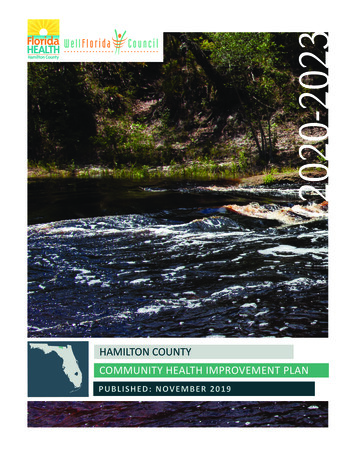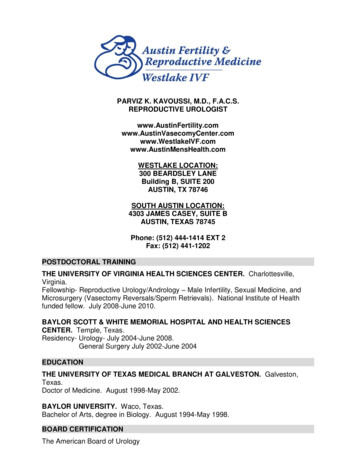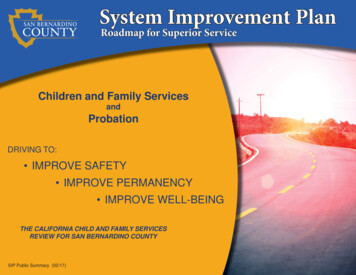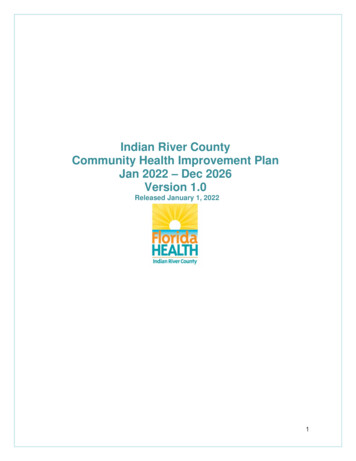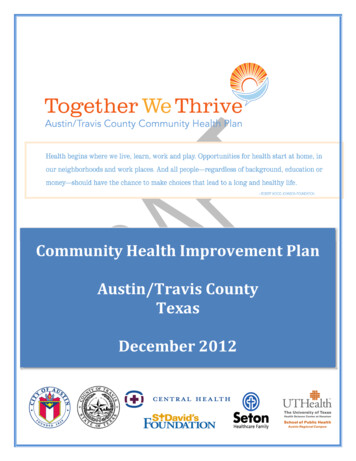
Transcription
Community Health Improvement PlanAustin/Travis CountyTexasDecember 2012
Dear Community Partner,This Community Health Improvement Plan illustrates four priority issues for which our community willwork together over the next 3-5 years to address in order to improve health and wellness. This has beena remarkable journey and we look forward to working with the community to make healthy people thefoundation of our thriving Austin/Travis County.From August 2011 through December 2012, Austin/Travis County Health and Human ServicesDepartment (A/TCHHSD) partnered with Travis County Health and Human Services and VeteransServices, Central Health, St. David’s Foundation, Seton Healthcare Family, and the University of TexasHealth Science Center (UTHSC) at Houston School of Public Health Austin Regional Campus to lead acomprehensive community health planning initiative. The community health improvement planningprocess was completed in December 2012 with a Community Health Assessment (CHA) and a draftCommunity Health Improvement Plan (CHIP) for Austin/Travis County.The Austin/Travis CHA represents a collaborative and community participatory process in order toillustrate our health status, strengths, and opportunities for the future. The Austin/Travis County CHIPillustrates the four priority issue areas that our community, including residents, businesses, partners,and stakeholders, will work together on addressing and improving.The drive, diligence, and support from the core partners, CHIP workgroup facilitators, and CHIPworkgroup members—our Austin/Travis County CHA team—made planning, conducting, andcompleting this improvement plan possible.Through our community’s health improvement planning process, we share our community’s collectivestory. Thank you for your ongoing contributions to this remarkable community health improvementprocess.Sincerely,Carlos RiveraDirector, Austin/Travis County HHSDShannon JonesChair of Steering CommitteeDeputy Director, Austin/Travis County HHSDDr. Philip HuangHealth Authority, Austin/Travis County HHSD2012 Austin/Travis County Community Health Improvement Plan (CHIP)Page ii
Table of ContentsExecutive Summary . 1AUSTIN/TRAVIS COUNTY COMMUNITY HEALTH IMPROVEMENT PLAN . 3Background . 3I. Overview of the Community Health Improvement Plan . 5A. What is a Community Health Improvement Plan? . 5B. How to use a CHIP . 5C. Methods . 5II.Prioritization of Health Issues . 7A.B.C.D.Community Engagement . 7Strategic Components of the CHIP . 7Development of Data-Based Community Identified Health Priorities . 8Development of the CHIP Strategic Components . 9III. CHIP Implementation Plan . 10Goals, Objectives, Strategies, Key Partners, and Output/Outcomes Indicators . 10A. Priority One: Chronic Disease – Focus on Obesity . 10B. Priority Two: Built Environment – Focus on Access to Healthy Foods. 17C. Priority Three: Built Environment – Focus on Transportation . 23D. Priority Four: Access to Primary Care and Mental/Behavioral Health Services – Focuson Navigating the Healthcare System . 27E. Relationship between the CHIP and other Guiding Documents and Initiatives . 39IV. Next Steps . 39V. Sustainability Plan . 39VI. Acknowledgements. 40APPENDICES . 42Appendix A: Chip Planning Session Workgroup Members . 43Priority Area One: Chronic Disease – Focus on Obesity .43Priority Area Two: Built Environment – Focus on Access to Healthy Foods .44Priority Area Three: Built Environment – Focus on Transportation.44Priority Area Four: Access to Primary Care and Mental/Behavioral Health Services – Focuson Navigating the Healthcare System.45Appendix B: Glossary of Terms. 46Appendix C: Austin/Travis County CHIP Alignment with State and National Priorities . 482012 Austin/Travis County Community Health Improvement Plan (CHIP)Page iii
EXECUTIVE SUMMARYWhere and how we live, work, play, and learn affects our health. Understanding how these factorsinfluence health is critical for developing the best strategies to address them. To accomplish these goals,Austin/Travis County Health and Human Services (ATCHHS) – in collaboration with Travis County Healthand Human Services and Veterans Services, Central Health, St. David’s Foundation, Seton HealthcareFamily, and the University of Texas Health Science Center at Houston School of Public Health AustinRegional Campus – led a comprehensive community health planning effort to measurably improve thehealth of Austin/Travis County, TX residents. This effort, funded by the National Association of Countyand City Officials with support from the Robert Wood Johnson Foundation, includes two major phases:1. A community health assessment (CHA) to identify the health related needs and strengths ofAustin/Travis County2. A community health improvement plan (CHIP) to determine major health priorities, overarchinggoals, and specific objectives and strategies that can be implemented in a coordinated wayacross Austin/Travis CountyIn addition to guiding future services, programs, and policies for these agencies and the area overall, theCHA and CHIP are also required prerequisites for the health department to earn accreditation, whichindicates that the agency is meeting national standards.The December 2012 Austin/Travis County CHIP was developed over the period July 2012 – November2012, using the key findings from the CHA , which included qualitative data from focus groups, keyinformant interviews and community forums that were conducted locally, as well as quantitative datafrom local, state and national indicators to inform discussions and determine health priority areas. TheCHA is accessible at www.austintexas.gov/healthforum.To develop a shared vision, plan for improved community health, and help sustain implementationefforts, the Austin/ Travis County assessment and planning process engaged community members andLocal Public Health System (LPHS) Partners through different avenues:a. the Steering Committee was responsible for overseeing the community health assessment,identifying the health priorities, and overseeing the development of the community healthimprovement planb. the Core Coordinating Committee was the overall management of the process, andc. the CHIP Workgroups, which represented broad and diverse sectors of the community, wereformed around each health priority area to develop the goals, objectives and strategies for theCHIP.The Steering Committee and the Core Coordinating Committee recognized that it was important tooutline a compelling and inspirational vision and mission, and to identify a set of shared values thatwould support the planning process and the CHIP itself. The Committees participated in severalbrainstorming, force field, and prioritization activities, and developed the following vision, mission andshared values for the CHA-CHIP:2012 Austin/Travis County Community Health Improvement Plan (CHIP)Page 1
VisionHealthy People are the Foundation of our Thriving CommunityMissionOur community – individuals and organizations (public, private, non-profit) –works together to create a healthy and sustainable Austin/Travis CountyShared ValuesEfficient, Results-Oriented, Data Driven, and Evidence Informed:Approach designed to improve overall health and disparitiesDiverse, Inclusive, Collaborative, and Respectful: Meaningful and respectfulengagement of diverse stakeholders, broadly defined; ensuring equality of voice andrepresentation in all approaches and processes, including vetting of group workHealth Promoting: Building on current assets and developing new assetsPerseverance, Excellence, and CreativityShared Accountability and OwnershipThe Steering and Core Coordinating Committees participated in a prioritization activity and identifiedthe following priority health issues that would be addressed in the CHIP:Priority Area 1: Chronic Disease – Focus on ObesityGoal 1: Reduce burden of chronic diseases caused by obesity among Austin/Travis Countyresidents.Priority Area 2: Built Environment – Focus on Access to Healthy FoodsGoal 2: All in our community have reasonable access to affordable quality nutritious food.Priority Area 3: Built Environment – TransportationGoal 3: Local and regional stakeholders will collaboratively increase accessibility tocommunity resources via safe, active transportation.Priority Area 4: Access to Primary Care and Mental/Behavioral Health Services - Focus onNavigating the Healthcare SystemGoal 4: Expand access to high-quality behaviorally integrated patient-centered medicalhomes for all persons.2012 Austin/Travis County Community Health Improvement Plan (CHIP)Page 2
Austin/Travis County Community Health Improvement PlanBACKGROUNDWhere and how we live, work, play, and learn affects our health. Understanding how these factorsinfluence health is critical for developing the best strategies to address them. To accomplish these goals,Austin/Travis County Health and Human Services (A/TCHHS) – in collaboration with Travis County Healthand Human Services and Veterans Services, Central Health, St. David’s Foundation, Seton HealthcareFamily, and the University of Texas Health Science Center at Houston School of Public Health AustinRegional Campus – led a comprehensive community health planning effort to measurably improve thehealth of Austin/Travis County, TX residents.The community health improvement planning process includes two major components:1. A community health assessment (CHA) to identify the health related needs and strengths ofAustin/Travis County2. A community health improvement plan (CHIP) to determine major health priorities, overarchinggoals, and specific objectives and strategies that can be implemented in a coordinated wayacross Austin/Travis CountyThe December 2012 Austin/Travis County CHIP was developed over the period July 2012 – November2012, using the key findings from the CHA , which included qualitative data from focus groups, keyinformant interviews and community forums that were conducted locally, as well as quantitative datafrom local, state and national indicators to inform discussions and determine health priority areas. TheCHA is accessible at www.austintexas.gov/healthforum.Moving from Assessment to PlanningSimilar to the process for the Community Health Assessment (CHA), the CHIP utilized a participatory,collaborative approach guided by the Mobilization for Action through Planning and Partnerships (MAPP)process.1 MAPP, a comprehensive, community-driven planning process for improving health, is astrategic framework that local public health departments across the country have employed to helpdirect their strategic planning efforts. MAPP comprises distinct assessments that are the foundation ofthe planning process, and includes the identification of strategic issues and goal/strategy formulation asprerequisites for action. Since health needs are constantly changing as a community and its contextevolve, the cyclical nature of the MAPP planning/implementation/evaluation/correction process allowsfor the periodic identification of new priorities and the realignment of activities and resources toaddress them.1Advanced by the National Association of County and City Health Officials (NACCHO), MAPP’s vision is forcommunities to achieve improved health and quality of life by mobilizing partnerships and taking strategicaction. Facilitated by public health leaders, this framework helps communities apply strategic thinking toprioritize public health issues and identify resources to address them. More information on MAPP can be foundat: 012 Austin/Travis County Community Health Improvement Plan (CHIP)Page 3
To develop a shared vision, plan for improved community health, and help sustain implementationefforts, the Austin/ Travis County HHSD led the assessment and planning process by engagingcommunity members and Local Public Health System (LPHS) Partners through different avenues:a) the Steering Committee was responsible for overseeing the community health assessment,identifying the health priorities, and overseeing the development of the community healthimprovement planb) the Core Coordinating Committee was the overall management of the process, andc) the CHIP Workgroups, which represented broad and diverse sectors of the community, wereformed around each health priority area to develop the goals, objectives and strategies for theCHIP.In January 2012, Austin/Travis County Health and Human Services hired Health Resources in Action(HRiA), a non-profit public health organization located in Boston, MA, as a consultant partner to providestrategic guidance and facilitation of the CHA-CHIP process, collect and analyze data, and develop thereport deliverables.The Steering and Core Coordinating Committees participated in brainstorming, force field analysis2, andprioritization activities to develop the vision, mission and shared values for the CHA-CHIP.In early July 2012, the CHA Report was distributed to the members of the Steering Committee for theirreview and feedback. On July 13, 2012, a summary of the CHA findings was presented to the SteeringCommittee, Core Coordinating Committee, executives from One Voice Central Texas (a networkrepresenting 54 health and human services community based organizations), and representatives fromthe City of Austin Planning and Development Review Department for review and refinement, and toserve as the official launching point for the CHIP.During this meeting, the group identified issues and themes from which priority health issues wereidentified and subcategories developed. While many areas were significant, it was emphasized thatidentifying a few priority areas would enable more focus and collaboration for impacting thecommunity. A multi-voting process using dots and agreed upon selection criteria was used to identifywhich of the subcategories within the four main priority health issues would be addressed in the CHIP.For a complete description of the selection process, please see Section II C.2As defined in the Public Healthy Memory Jogger II by Goal/QPC, a “force field analysis is used to investigate thebalance of power involved in resolving an issue. It presents the ‘positives’ and ‘negatives’ of a situation for easycomparison. Force fields allow teams to come to a collective decision about a permanent result, and encouragehonest consideration of real underlying root causes and solutions”.2012 Austin/Travis County Community Health Improvement Plan (CHIP)Page 4
I.OVERVIEW OF THE COMMUNITY HEALTH IMPROVEMENT PLANA. What is a Community Health Improvement Plan?A Community Health Improvement Plan, or CHIP, is an action-oriented strategic plan thatoutlines the priority health issues for a defined community, and how these issues will beaddressed, including strategies and measures, to ultimately improve the health of thecommunity. CHIPs are created through a community-wide, collaborative planning process thatengages partners and organizations to develop, support, and implement the plan. A CHIP isintended to serve as a vision for the health of the community and a framework fororganizations to use in leveraging resources, engaging partners, and identifying their ownpriorities and strategies for community health improvement.3B. How to use a CHIPA CHIP is designed to be a broad, strategic framework for community health, and should bemodified and adjusted as conditions, resources, and external environmental factors change. Itis developed and written in a way that engages multiple perspectives so that all communitygroups and sectors – private and nonprofit organizations, government agencies, academicinstitutions, community- and faith-based organizations, and citizens – can unite to improvethe health and quality of life for all people who live, work, learn, and play in Austin/TravisCounty. We encourage you to review the priorities and goals, reflect on the suggestedstrategies, and consider how you can participate in this effort.C. MethodsBuilding upon the key findings and themes identified in the Community Health Assessment(CHA), the CHIP aims to: Identify priority issues for action to improve community health Develop and implement an improvement plan with performance measures forevaluation Guide future community decision-making related to community healthimprovementIn addition to guiding future services, programs, and policies for participating agencies and thearea overall, the community health improvement plan fulfills the required prerequisites forthe Austin/Travis County Health and Human Services Department to be eligible foraccreditation, which indicates that the agency is meeting national standards.To develop the CHIP, the Austin/Travis County Health and Human Services Department wasthe convening organization that brought together community residents and the area’sinfluential leaders in healthcare, community organizations, and other key sectors, such astransportation, mental health, local government, and social services. Following the guidelinesof the National Association of County and City Health Officials (NACCHO), the communityhealth improvement process was designed to integrate and enhance the activities of manyorganizations’ contributions to community health improvement, building on current assets,enhancing existing programs and initiatives, and leveraging resources for greater efficiencyand impact.3As defined by the Health Resources in Action, Strategic Planning Department, 20122012 Austin/Travis County Community Health Improvement Plan (CHIP)Page 5
The sessment process is a continuouscycle of improvement that seeks to “move the needle” on key health priorities over the courseof time. The cyclical nature of the Core Public Health Functions described above is illustratedbelow in Figure 1.The next phase of the CHIP will involve broad implementation of the strategies and actionplan identified in the CHIP, and monitoring/evaluation of the CHIP’s short-term and long-termoutcome indicators.Figure 1: The Cyclical Nature of the Core Public Health FunctionsSource: Centers for Disease Control and Prevention (CDC), Ten Essential Public Health Services2012 Austin/Travis County Community Health Improvement Plan (CHIP)Page 6
II.PRIORITIZATION OF HEALTH ISSUESA. Community EngagementThe Austin/Travis County Department of Health and Human Services led the planning processfor Austin/Travis County and oversaw all aspects of the CHIP development, including theestablishment of CHIP Workgroups and to flesh out details for identified health priorities. TheCore Coordinating Committee and the Steering Committee continued from the AssessmentPhase to the Planning Phase, guiding all aspects of planning and offering expert input on plancomponents.CHIP Workgroup members were comprised of individuals with expertise and interest inidentified priority areas who volunteered to participate and who represented broad anddiverse sectors of the community. See Appendix A for workgroup participants andaffiliations.B. Strategic Components of the CHIPThe Steering Committee and the Core Coordinating Committee recognized that it wasimportant to outline a compelling and inspirational vision and mission, and to identify a set ofshared values that would support the planning process and the CHIP itself. The Committeesparticipated in several brainstorming, force field, and prioritization activities, and developedthe following vision, mission and shared values for the CHA-CHIP:VisionHealthy People are the Foundation of our Thriving CommunityMissionOur community – individuals and organizations (public, private, non-profit) –works together to create a healthy and sustainable Austin/Travis CountyShared ValuesEfficient, Results-Oriented, Data Driven, and Evidence Informed:Approach designed to improve overall health and disparitiesDiverse, Inclusive, Collaborative, and Respectful: Meaningful and respectfulengagement of diverse stakeholders, broadly defined; ensuring equality of voice andrepresentation in all approaches and processes, including vetting of group workHealth Promoting: Building on current assets and developing new assetsPerseverance, Excellence, and CreativityShared Accountability and Ownership2012 Austin/Travis County Community Health Improvement Plan (CHIP)Page 7
C. Development of Data-Based Community Identified Health PrioritiesOn July 13, 2012, a summary of the CHA findings was presented to the Steering Committee,Core Coordinating Committee and representatives from One Voice Central Texas and the Cityof Austin Planning and Development Review Department for further discussion. The followingthemes emerged most frequently from review of the available data and were considered inthe selection of the CHIP health priorities:Health Priority Areas Built Environment Transportation Affordable Housing Food Access Physical Activity AccessChronic Disease and Related Conditions Obesity Diabetes Heart Disease CancerMental Health Stress and Depression Co-occurring Disorders(e.g., substance abuse) Accessing Services Stigma/DiscriminationAccess to Primary Care Health Facilities/Resources Emergency Room Overuse Health Insurance/Cost Navigating the Health Care SystemFacilitators used a multi-voting process to identify the four most important public healthissues for Austin/Travis County from the list of major themes identified from the CHA. Eachparticipant received four dots to apply to their top four public health priorities, afterreviewing, discussing, and agreeing upon the following common set of selection criteria:Political will exists to support changeCommunity Values Community cares about it People, power and passion:Likely community mobilization Important to communityKey area of need (based on data) Size: Many people affected Trend: Getting worse Seriousness: Deaths,hospitalizations, disabilities Causes: Can identify rootcauses/social determinants Research/evidence-basedAchievable/doable Feasible and realisticResources available or likely Builds on or enhances current workMeasurable outcomesCan move the needle Proven strategies to addressmultiple wins/catalytic actions Easy short-term winsPopulation Based Strategies Some groups affected more Can focus on targeted population(s)This process was followed by a show of hands vote, which resulted in the selection of thesame issues and sub categories identified during the multi voting process. The dot votingprocess was one that was conducted in a short amount of time with a sizable group of peoplemade up of both Steering Committee and Core Leadership members.2012 Austin/Travis County Community Health Improvement Plan (CHIP)Page 8
Based on the results of the multi-voting exercise, the Steering Committee and Core Leadershipmembers agreed upon the following four health priority areas for the CHIP: Chronic Disease – focus on obesityBuilt Environment – focus on Access to Healthy FoodsBuilt Environment- focus on TransportationAccess to Primary Care and Mental Health /Behavioral Health Services – focus onimproving access to primary care, improving access to mental health, and helpingconsumers navigate both systemsSteering Committee Members also suggested that health education/health literacy beincluded as cross-cutting strategies for each of the CHIP priorities, as appropriate. Access toHealthy Foods, Transportation, and Access to Primary Care and Mental/Behavioral HealthServices were all identified as priorities aimed at addressing a social determinant of healthinequity in Austin/Travis County. The social determinants of health are the circumstances inwhich people are born; grow up, live, work, and age, as well as the systems put in place todeal with illness. These circumstances in turn are shaped by a wider set of forces: economics,social policies, and politics.4 Addressing the role of social determinants of health is importantbecause it is a primary approach to achieving health equity. Health equity exists wheneveryone has the opportunity to attain their full potential and no one is disadvantaged.5D. Development of the CHIP Strategic ComponentsThe Core Planning Group convened five, three hour planning sessions between August andOctober 2012. Community members and LPHS partners were invited to participate in workinggroups based on interest and expertise in each of the four identified priority areas. SeeAppendix A for a list of workgroup participants and affiliations.A HRiA consultant facilitated the joint workgroup sessions, and 3-4 person teams comprised ofCore Planning Group Members and local content experts facilitated the breakout sessions forall five planning meetings, resulting in draft goals, objectives, strategies, and performanceindicators. The CHIP Workgroups utilized a template Implementation Plan that was adaptedfrom the Wisconsin CHIP Infrastructure Project and was modified for the Austin / TravisCounty Community Health Improvement Process Action Plan.6The Core Planning Group and HRiA provided sample evidence based strategies from a varietyof resources including the Community Guide to Preventive Services, County Health Rankings,and the National Prevention Strategy for the strategy setting sessions. As policy is inherentlytied to sustainability and effectiveness, workgroups indicated whether or not strategyimplementation would necessitate policy changes. In addition, as noted by one of the localcontent experts Andrew Springer, “the strategies were meant to be broad enough to allow forcreative thinking in terms of how to operationalize the strategy”.4The World Health Organizationhttp://www.who.int/social determinants/thecommission/finalreport/key concepts/en/index.html5Brennan Ramirez LK, B.E., Metzler M., Promoting Health Equity: A Resource to Help Communities Address SocialDeterminants of Health, Centers for Disease Control and Prevention, Editor. 2008, Department of Health andHuman Services,: Atlanta, GA.)6The Wisconsin CHIP Implementation Plan is accessible via the following ementationPlanv1.0.doc2012 Austin/Travis County Community Health Improvement Plan (CHIP)Page 9
The Core Planning Group, the HRiA consultants and the Workgroup facilitators reviewed thedraft output from the planning sessions and edited material for clarity, consistency, andevidence base. This feedback was incorporated into the final versions of the CHIP contained inthis report.III.CHIP IMPLEMENTATION PLANGoals, Objectives, Strategies, Key Partners, and Output/Outcomes IndicatorsReal, lasting community change stems from critical assessment of current conditions, anaspirational framing of the desired future, and a clear evaluation of whether efforts aremaking a difference. Output and Outcome indicators tell the story about where a communityis in relation to its vision, as articulated by its related goals, objectives, and strategies.The following pages outline the Goals, Objectives, Strategies, Potential Output and OutcomesIndicators, and Potential Partners/Resources for the four health priority areas outlined in theCHIP. Data from the Community Health Assessment is included in the beginning section ofeach priority area. See Appendix B for a glossary of terms used in the CHIP.A. Priority One: Chronic Disease – Focus on ObesityThe quantitative results in the Austin/Travis County 2012 CHA show that in 2008-2010, thepercentage of obese adults in Travis County (24.0%) was less than that of the state (29.6%),both of which are better than the HP2020 target (30.6%). It also showed however, that theobesity epidemic is much more severe in communities of color. Locally in Austin/TravisCounty, obesity among adult Blacks/African Americans is 41.7% and among Latinos/Hispanicsit is 36.5% compared to less than 20% of Whites (19.4%).7 This pattern is consistent for theyouth population (grades 9-12), where the percentage of obese youth at the county level(10.1%
The community health improvement planning process includes two major components: 1. A community health assessment (CHA) to identify the health related needs and strengths of Austin/Travis County 2. A community health improvement plan (CHIP) to determine major health priorities, overarching
